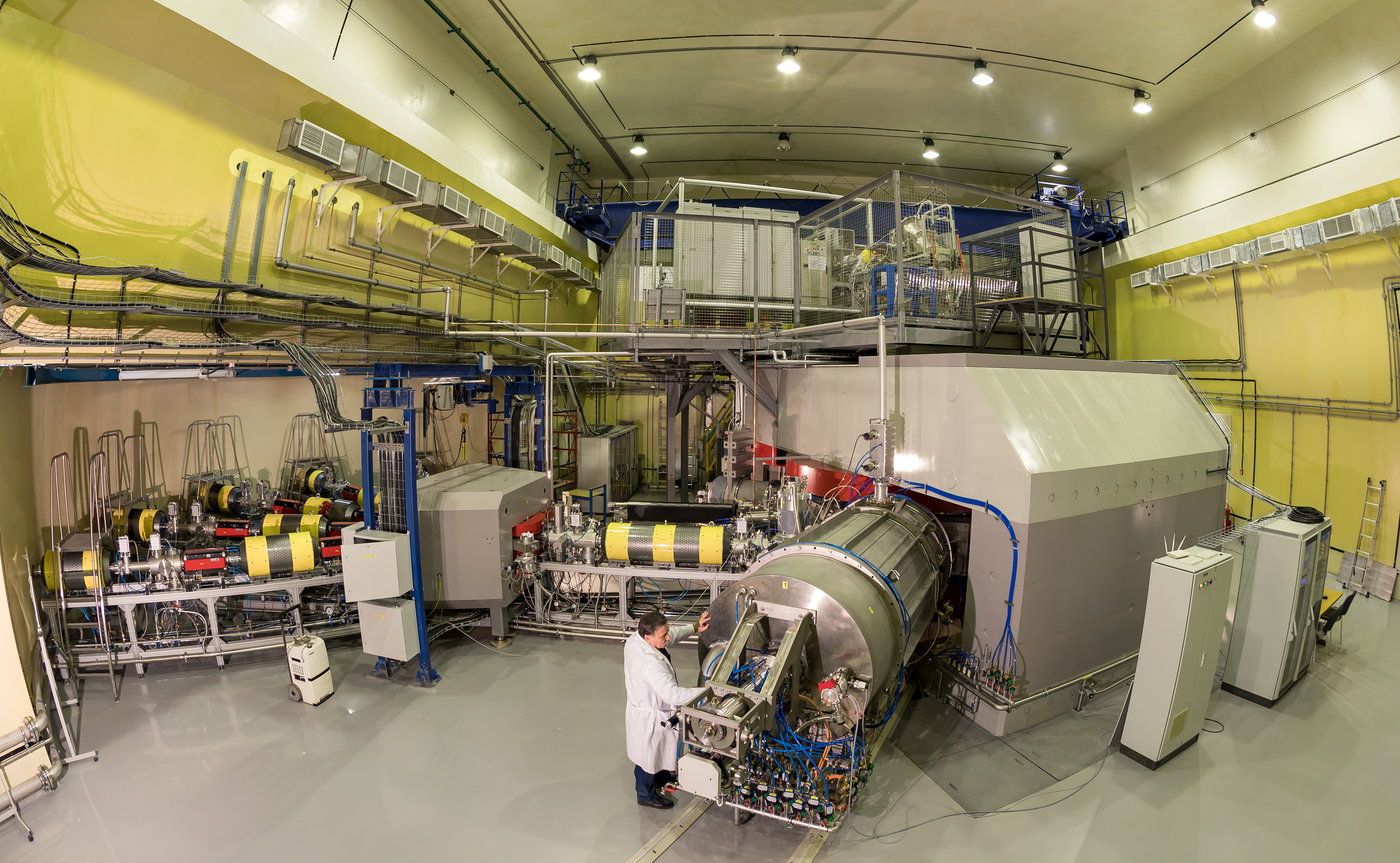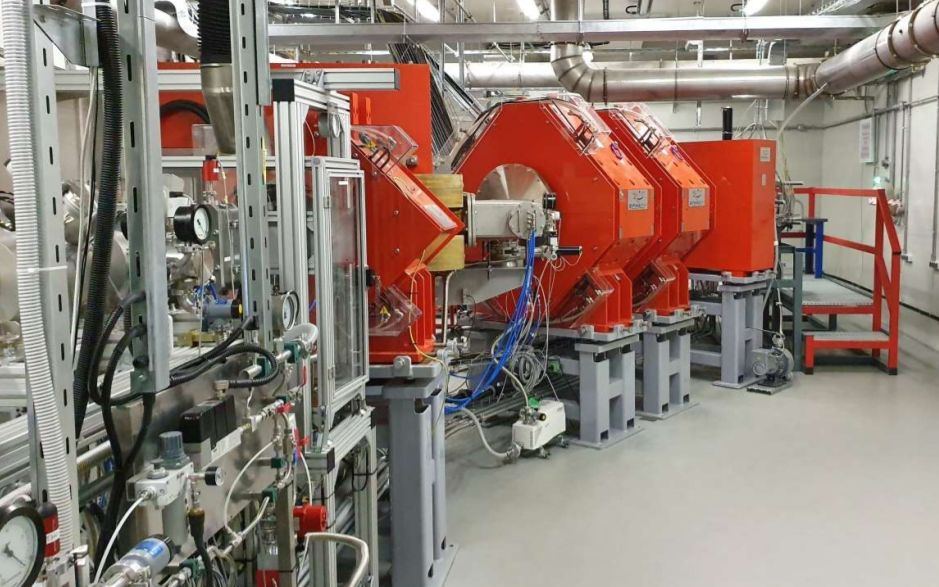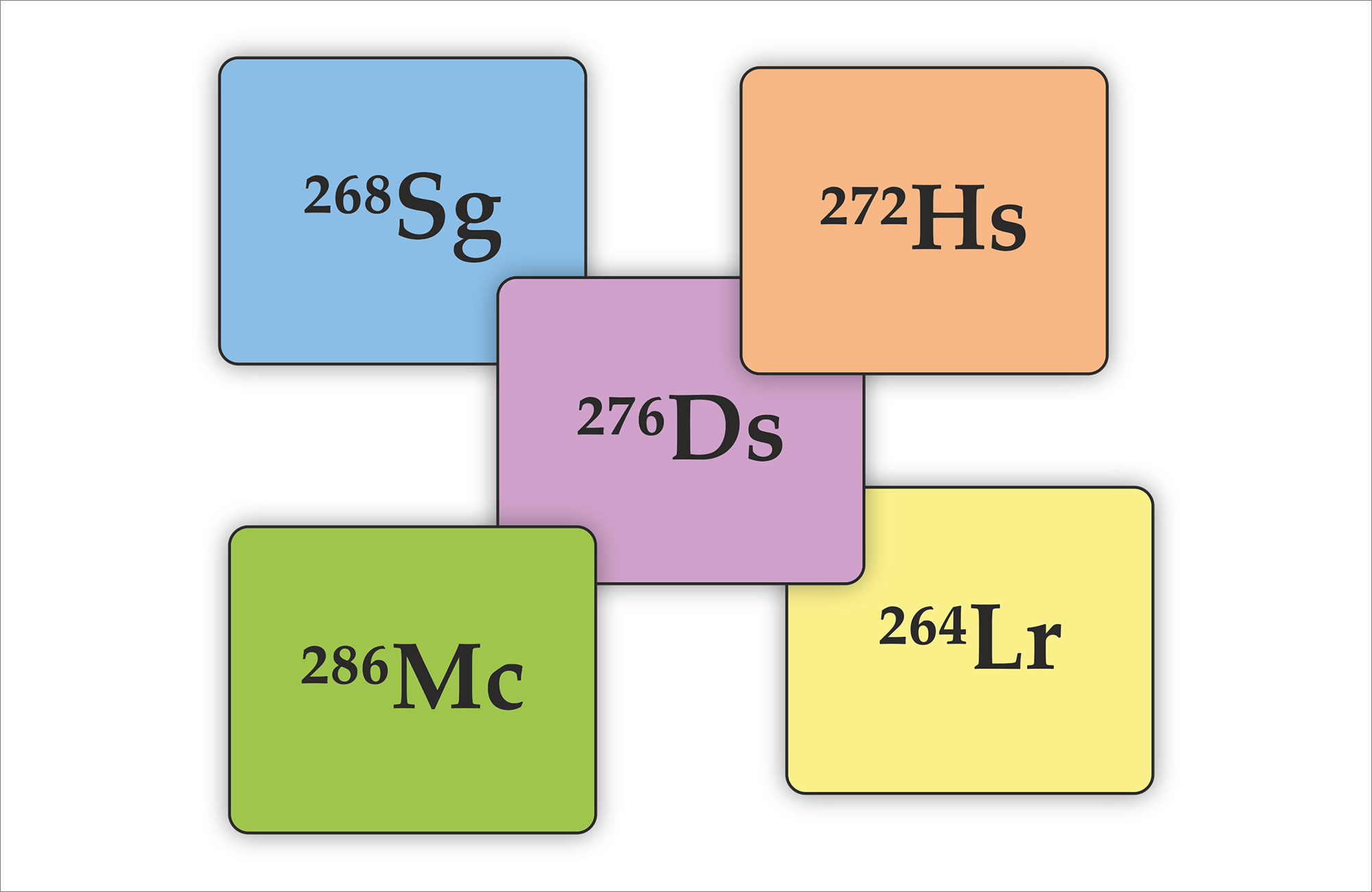Five new isotopes synthesised at Superheavy Element Factory
News, 01 February 2023
During the operation of the Superheavy Element Factory (SHE) at the Flerov Laboratory of Nuclear Reactions JINR in 2020 – 2022, scientists synthesised five new isotopes of superheavy elements such as 264Lr, 286Mc, 276Ds, 272Hs, and 268Sg. The fact that for the two years of operation of the Factory several previously unknown isotopes have been discovered at the same time indicates that this is an advanced research complex that sets new standards in the field of synthesis and study of the properties of superheavy elements.
Researchers synthesised lawrencium-264 during the first experiments at the SНE Factory on the synthesis of moscovium isotopes in the 48Ca+243Am reaction. The lifetime of the new nuclide was about five hours. This experiment repeated reactions that had already been studied earlier not only at FLNR, but also in scientific centres in Germany, Japan, and the USA.
“In the first experiment, in these seemingly well-known and well-studied reactions, we saw a new isotope of lawrencium-264. For us, this was an indicator that the Superheavy Element Factory really works as it was designed, and surpasses the capabilities of the previous generation facilities,” Scientific Secretary of FLNR Alexander Karpov commented. He added that the most important factor influencing the discovery of lawrencium-264 was good background conditions in the focal plane of the Factory’s first separator called DGFRS-II (Dubna Gas-Filled Recoil Separator). It is able to separate events unrelated to the synthesis of superheavy elements extremely efficiently. According to the scientist, it was previously believed that moscovium-288 decays through the chain of several alpha decays and ends with the spontaneous fission of dubnium-268 about a day later. However, the FLNR scientists managed to establish that in almost half of the cases dubnium actually divided. As for remaining ~50% of cases, it emits an alpha particle, forming lawrencium-264, which has not been observed before. Scientists recorded about 50 formation events of 264Lr among 110 formation events of 288Mc.
One more strength of the SHE Factory is its high performance, which allows collecting statistics much faster. Therefore, in one experiment it is sometimes possible to study a reaction at several beam energies, while working with extremely low cross-sections (possibility of formation) of synthesis, which enables to obtain completely new information. Thus, in 2021, at the SHE Factory, specialists obtained one event of the formation of a new isotope, moscovium-286, with lifetime of only 20 milliseconds. “We managed to discover this isotope precisely because now researchers collect statistics many times faster than it was before,” Alexander Karpov highlighted.
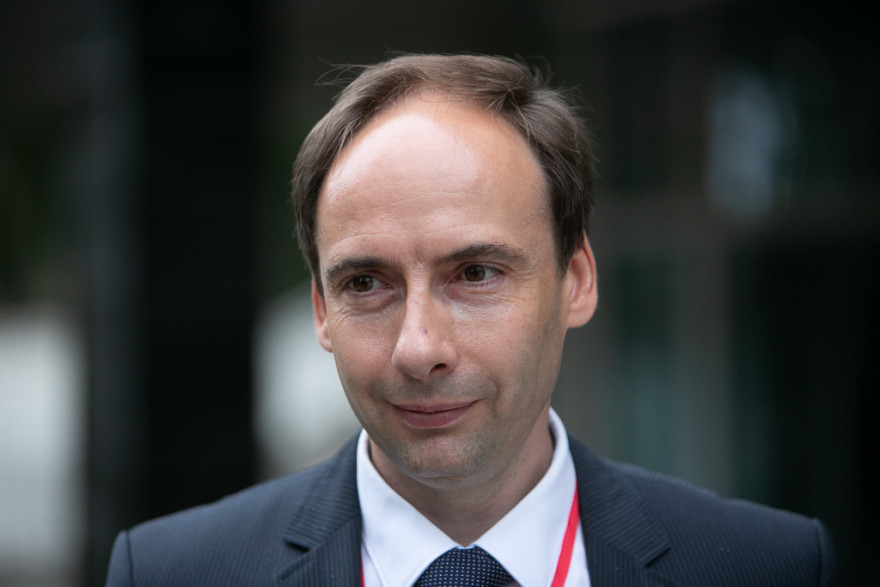 FLNR JINR Scientific Secretary Alexander Karpov
FLNR JINR Scientific Secretary Alexander Karpov
In the experiment of 2022, scientists used a reaction that had not been studied before anywhere else in the world, i.e. the interaction of the calcium-48 beam with the thorium-232 target material. This combination formed three isotopes previously unknown before such as darmstadtium-276 (6 events), hassium-272, and seaborgium-268 (two events each). It turned out that darmstadtium-276 decayed into hassium-277 through alpha decay within fractions of a millisecond. In its turn, in one hundred milliseconds, hassium decays into seaborgium-268, which decays through spontaneous fission within 10-15 seconds.
The main purpose of this experiment is to prepare for the synthesis of element 120 of the Periodic Table. The theory predicts that a minimum cross-section was expected for the calcium-thorium reaction. Cross sections in the reaction with calcium-48 increase when moving both to lighter elements and to heavier ones. As for element 110, darmstadtium, the theory predicted its minimum. “It was very important to try to synthesise at the Factory an isotope with its expected survival rate even lower than for element 120 in order to demonstrate that we can conduct experiments with very low cross-sections. Lower than we have worked on until now. This was also achieved,” Alexander Karpov explained.
The second reason why it was important to conduct the research was that the isotopes of element 120, which could be obtained in one of the possible synthesis reactions, would decay through the chain of darmstadtium-276, hassium-272, and seaborgium-268. “Therefore, it was very important to obtain these isotopes separately to study their properties, so that later, when observing the synthesis events of element 120, we would definitely be sure about correct identification of isotopes,” Alexander Karpov added.
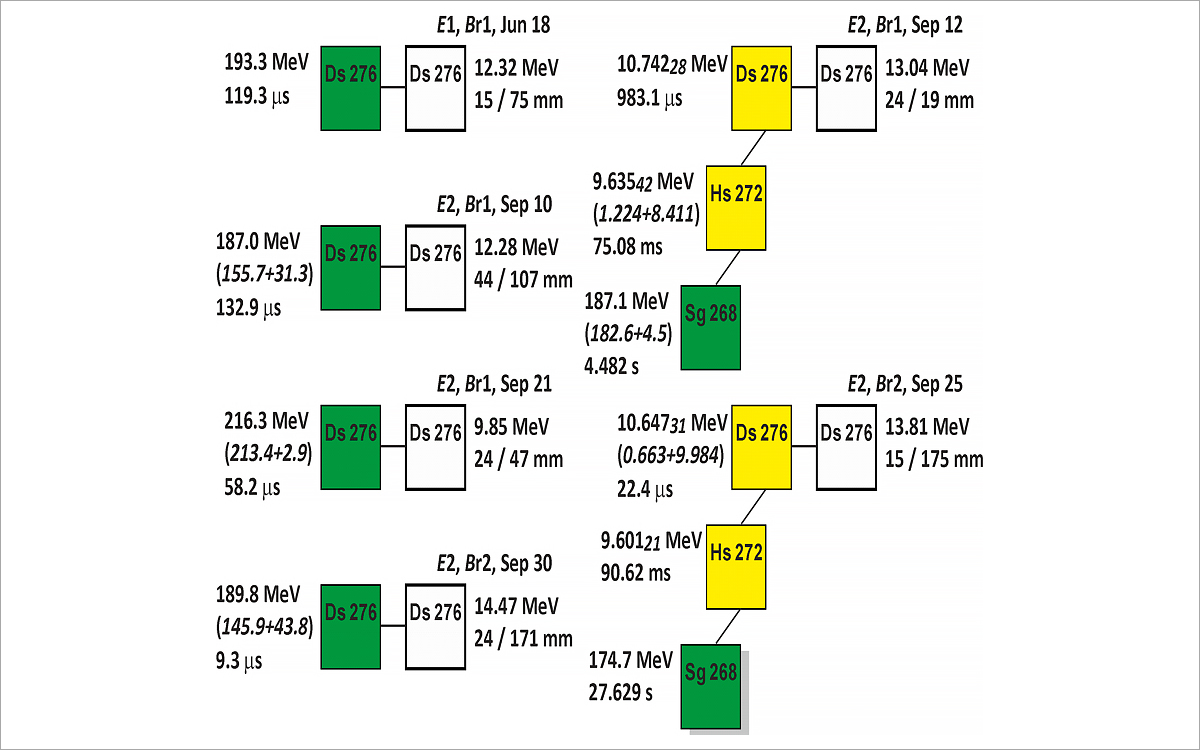 3 new isotopes – 276Ds, 272Hs, and 268Sg – were obtained in the 48Ca + 232Th reaction
3 new isotopes – 276Ds, 272Hs, and 268Sg – were obtained in the 48Ca + 232Th reaction
In the spring of 2023, at FLNR JINR, scientists are going to continue studying the calcium-thorium reaction, but at a higher beam energy. Researchers can hope both to clarify the properties of the newly discovered darmstadtium-276 and to synthesise other yet unknown isotopes of this element such as darmstadtium-275 and darmstadtium-274.
“For two years of work, we have managed to obtain as many as five new isotopes. This result points to the fact that the SHE Factory is really an extra-class complex for the synthesis and study of superheavy elements,” FLNR Scientific Secretary highlighted. Parameters of both the accelerator and separators of the Factory were initially adapted for the most efficient solution of problems in the field of physics and chemistry of superheavy elements. “All our experience in creating accelerators and separators, which has been accumulated over the previous decades, has been invested in this accelerator complex, taking into account all the ideas for improving the parameters of the facilities. In fact, we did our best,” Alexander Karpov said.
The advantage of the specialised complex is also that FLNR scientists have the opportunity to work at it almost all year round. As for other accelerator complexes in other scientific centres, they have to divide the run time between research groups working in different directions. “We have an advantage in both time and access to the target material and the material forming the beam. The accelerator complex of the Superheavy Element Factory is really the leader in the world by all parameters now,” Alexander Karpov summed up.
The Superheavy Element Factory created on the initiative of Scientific Leader of the Flerov Laboratory of Nuclear Reactions Academician Yuri Oganessian holds the world leadership in the field of synthesis and study of the properties of superheavy elements. The ceremonial opening of the experimental hall of the Superheavy Element Factory and launch of its basic facility – the DC-280 cyclotron – were held on 25 March 2019. The designed intensity of accelerated heavy ion beams of calcium-48 produced at the DC-280 Accelerator is 60 trillion ions per second, that 10 times exceeds intensities achieved at the operating facilities all over the world. One of the key tasks of the accelerator complex is the synthesis of new superheavy elements with numbers 119 and 120, the first elements of the eighth period of the Mendeleev’s Periodic Table of Chemical Elements. For the synthesis of such heavy elements, as well as for a detailed study of the nuclear and chemical properties of elements already known, it was necessary to significantly, by tenfold, increase the efficiency of the experiments carried out, as it was done at the Factory.
To implement the project, JINR specialists have constructed a modern experimental building equipped with all the necessary engineering systems to ensure work with highly radioactive substances. In addition to the DC-280 accelerator complex, the Factory includes two gas-filled recoil separator such as DGFRS-II and GRAND.
The first experiment dedicated to the synthesis and study of moscovium and its decay products was conducted at the Factory in the second half of 2020. It was included in the list of tasks under the grant of the Ministry of Science and Higher Education of the Russian Federation 2020-2022 “Superheavy nuclei and atoms: limits of nuclear mass and the boundaries of the Mendeleev’s Periodic Table”. Grant Scientific Leader is Academician Yuri Oganessian, Scientific Leader of the Laboratory of Nuclear Reactions JINR. Grant Administrative Head is FLNR Scientific Secretary Alexander Karpov.
The programme of experiments on the synthesis of new isotopes of superheavy elements is implemented with the leading participation of JINR scientists. Representatives of Russia, Kazakhstan, and the Czech Republic are among its co-authors. JINR scientists work in cooperation with scientists of Oak Ridge National Laboratory in the USA, and the Institute of Modern Physics of the Chinese Academy of Sciences. The material for actinide targets and the beam (calicium-48) has been developed at the enterprises of the State Corporation “Rosatom” (Russia).
Literature:
- Yu.Ts. Oganessian, V.K. Utyonkov, A.G. Popeko, D.I. Solovyev, F.Sh. Abdullin, S.N. Dmitriev, D. Ibadullayev, M.G. Itkis, N.D. Kovrizhnykh, D.A. Kuznetsov, O.V. Petrushkin, A.V. Podshibiakin, A.N. Polyakov, R.N. Sagaidak, L. Schlattauer, I.V. Shirokovsky, V.D. Shubin, M.V. Shumeiko, Yu.S. Tsyganov, A.A. Voinov, V.G. Subbotin, V.V. Bekhterev, N.A. Belykh, O.A. Chernyshev, K.B. Gikal, G.N. Ivanov, A.V. Khalkin, V.V. Konstantinov, N.F. Osipov, S.V. Paschenko, A.A. Protasov, V.A. Semin, V.V. Sorokoumov, K.P. Sychev, V.A. Verevochkin, B.I. Yakovlev, S. Antoine, W. Beeckman, P. Jehanno, M.I. Yavor, A.P. Shcherbakov, K.P. Rykaczewski, T.T. King, J.B. Roberto, N.T. Brewer, R.K. Grzywacz, Z.G. Gan, Z.Y. Zhang, M.H. Huang, H.B. Yang. DGFRS-2 –A gas-filled recoil separator for the Dubna Super Heavy Element Factory. Nuclear Inst. and Methods in Physics Research, A 1033 (2022) 166640.
- D.I. Solovyev and N.D. Kovrizhnykh. Simulations of recoil trajectories in Dubna Gas-Filled Recoil Separator 2 by GEANT4 toolkit. J. Instrum. 17, P07033 (2022).
- Yu.Ts. Oganessian, V.K. Utyonkov, D. Ibadullayev, F.Sh. Abdullin, S.N. Dmitriev, M.G. Itkis, A.V. Karpov, N.D. Kovrizhnykh, D.A. Kuznetsov, O.V. Petrushkin, A.V. Podshibiakin, A.N. Polyakov, A.G. Popeko, R.N. Sagaidak, L. Schlattauer, V.D. Shubin, M.V. Shumeiko, D.I. Solovyev, Yu.S. Tsyganov, A.A. Voinov, V.G. Subbotin, A.Yu. Bodrov, A.V. Sabel’nikov, A. Lindner, K.P. Rykaczewski, T.T. King, J.B. Roberto, N.T. Brewer, R.K. Grzywacz, Z.G. Gan, Z.Y. Zhang, M.H. Huang, and H.B. Yang. Investigation of 48Ca-induced reactions with 242Pu and 23823U targets at the JINR Superheavy Element Factory. Phys. Rev. C 106, 026412 (2022).
- Yu. Ts. Oganessian, V. K. Utyonkov, N. D. Kovrizhnykh, F. Sh. Abdullin, S. N. Dmitriev, D. Ibadullayev, M. G. Itkis, D. A. Kuznetsov, O. V. Petrushkin, A. V. Podshibiakin, A. N. Polyakov, A. G. Popeko, R. N. Sagaidak, L. Schlattauer, I. V. Shirokovski, V. D. Shubin, M. V. Shumeiko, D. I. Solovyev, Yu. S. Tsyganov, A. A. Voinov, V. G. Subbotin, A. Yu. Bodrov, A. V. Sabel’nikov, A. V. Khalkin, V. B. Zlokazov, K. P. Rykaczewski, T. T. King, J. B. Roberto, N. T. Brewer, R. K. Grzywacz, Z. G. Gan, Z. Y. Zhang, M. H. Huang, and H. B. Yang. First experiment at the Super Heavy Element Factory: High cross section of 288Mc in the 243Am+48Ca reaction and identification of the new isotope 264Lr. Phys. Rev. C 106, L031301 (2022).
- Yu. Ts. Oganessian, V. K. Utyonkov, N. D. Kovrizhnykh, F. Sh. Abdullin, S. N. Dmitriev, A. A. Dzhioev, D. Ibadullayev, M. G. Itkis, A. V. Karpov, D. A. Kuznetsov, O. V. Petrushkin, A. V. Podshibiakin, A. N. Polyakov, A. G. Popeko, I. S. Rogov, R. N. Sagaidak, L. Schlattauer, V. D. Shubin, M. V. Shumeiko, D. I. Solovyev, Yu. S. Tsyganov, A. A. Voinov, V. G. Subbotin, A. Yu. Bodrov, A. V. Sabel’nikov, A. V. Khalkin, K. P. Rykaczewski, T. T. King, J. B. Roberto, N. T. Brewer, R. K. Grzywacz, Z. G. Gan, Z. Y. Zhang, M. H. Huang, and H. B. Yang. New isotope 286Mc produced in the 243Am + 48Ca reaction. Phys. Rev. C 106, 064306 (2022).
- Reports of Yu. Ts. Oganessian, V. K. Utyonkov, A. V. Karpov, and D. Ibadullaev at the Meeting on Heavy Ion Physics, St. Petersburg, 3 – 9 July 2022.
